Delaware • New Jersey • Pennsylvania
New York • United States of America
The DRBC knows that you can't manage what you don't measure and employs a robust water quality monitoring program to ensure criteria are being met. Right now, our summer monitoring season is in full swing. From protecting the existing high water quality of the non-tidal Delaware River to monitoring bacteria in the Delaware Estuary, read more below about the programs we are collecting data for this summer.
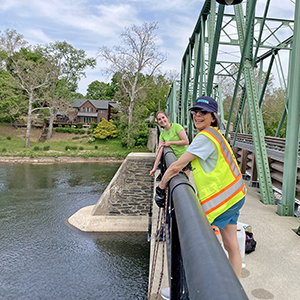 |
| DRBC staff collects a water sample. Photo by the DRBC. |
This summer, staff began a No Measurable Change Assessment for its Special Protection Waters (SPW) Monitoring Program, which protects the existing high water quality in the non-tidal Delaware River.
•Learn more about the SPW Program
• Samples will be collected May - September, twice a month.
• Samples will be collected from 17 sites.
• National Park Service staff will monitor the upper & middle Delaware.
• DRBC staff will monitor the lower Delaware.
• Parameters include Alkalinity, Chloride, Hardness, Sulfate, TSS, TDS, Nirtate+Nitrite, Total Nitrogen, Ammonia, TKN, TP, Silica, Ca, Mg, Na, K, DO, turbidity, pH and water temperature.
During this time period, staff will also develop a plan to rotate monitoring sites every 3 years for recurring measurable change assessments, as well as examine defining existing water quality at additional sites.
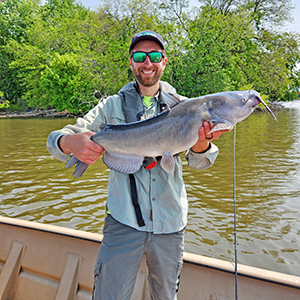 |
| DRBC staff holds a large catfish caught in the Delaware River. Photo by the DRBC. |
This summer, staff will continue monitoring for PFAS, a contaminant of emerging concern.
• Learn more about PFAS.
• Staff will monitor for 40 different analytes of PFAS in surface water, sediment and fish tissue.
• Samples will be collected at various sites in both the tidal and non-tidal Delaware River, from Lackawaxen, Pa. to Pea Patch Island, Del.
• Channel catfish and white perch will be collected from the tidal Delaware River.
• White sucker and smallmouth bass will be collected from the non-tidal Delaware River.
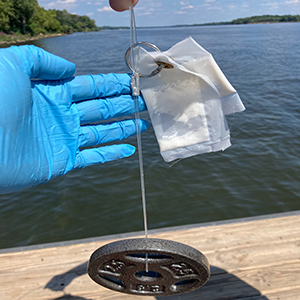 |
| SPATT bags about to be deployed in the Delaware River. Photo by the DRBC. |
The DRBC will repeat the SPATT (Solid Phase Adsorption Toxins Tracking) methodology to track the presence or absence of cyanotoxins in the mainstem non-tidal Delaware River. This methodology was used in 2022 in the tidal mainstem Delaware River.
• Learn more about the DRBC's Cyanotoxin Study.
• DRBC staff will construct the SPATT bags.
• The SPATT bags will be deployed at 15 locations.
• The deployment will be done in August/September, the deployment period will be 8 days.
• The environmental lab at DNREC will analyze for the presence of Microcystin, cylindrospermopsin, and anatoxin-a, all harmful algal bloom toxins.
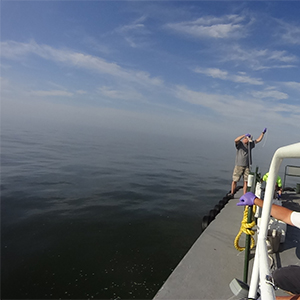 |
| DNREC staff performing Delaware Estuary Water Quality Monitoring. Photo courtesy of DNREC. |
Initiated in 1967, DRBC's Delaware Estuary Water Quality Monitoring Program (aka the Boat Run) is one of the longest running monitoring programs in the world.
• Learn more about this monitoring program.
• The DRBC contracts DNREC to perform the monitoring work.
• 22 sites are monitored once monthly, from March through October, in the Delaware River Estuary
• Parameters monitored include bacteria, dissolved oxygen, pH, temperature, specific conductance, turbidity, nutrients (ammonia, nitrate + nitrite, phosphorus), chlorides and metals.
• The bacteria data are posted on the DRBC website (see above link); all other data are available via the U.S. EPA's Water Quality Portal.
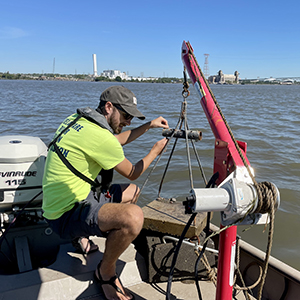 |
| DRBC staff prep to deploy a DO logger in the Delaware Estuary. Photo by the DRBC. |
Last year, the DRBC initiated a study of dissolved oxygen (DO) trends in areas considered nursery grounds for juvenile endangered Atlantic sturgeon. This study is being repeated in 2023.
• Learn more about this effort.
• The DO loggers will be deployed by Marcus Hook, Pa., which has been identified as critical nursery grounds/habitat for juvenile Atlantic sturgeon.
• The loggers deployed at several locations (top and bottom) during July through September, targeting low flows.
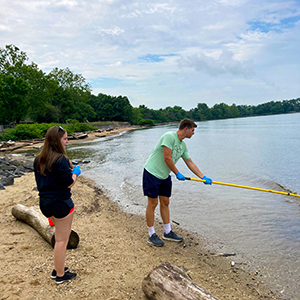 |
| DRBC staff collects a water sample to monitor for bacteria. Photo by the DRBC. |
The DRBC is continuing to study bacteria levels in a section of the Delaware River Estuary to see if conditions comply with stricter water quality criteria for primary contact recreation.
• Learn more about DRBC's near-shore bacteria monitoring.
• This summer, the DRBC will target rain events - collecting data before, during and after to track trends.
• Locations to be monitored will be a subset of the locations previousy monitored for the near-shore monitoring study.
Copyright © Delaware River Basin Commission,
P.O. Box 7360, West Trenton, NJ 08628-0360
Phone (609)883-9500; Fax (609)883-9522
Thanks to NJ for hosting the DRBC website